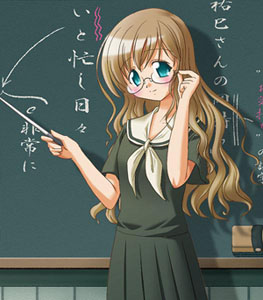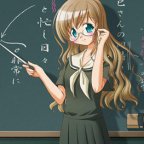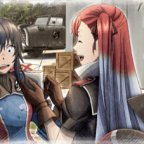Beginner’s Japanese – Chapter 0 – Prologue
Instead of preparing for the finals of the speech contest tomorrow, I have decided to start a series of lessons to introduce some aspects of Japanese grammar to the those who are interested in learning about this curious language we all know as “moonspeak”.

This is not intended as a lesson to teach Japanese to any point of fluency, but rather it’s just a brief introduction to various Japanese grammar forms and whatever else I think of when I am typing them. I intend to make this a semi-regular section, but I might run out of things or feel lazy along the way, so we’ll see how many chapters I can last.
First, we need to go through some basic terms… just in case.
Writing System
Japanese has three sets of written characters, hiragana (ひらがな), katakana (カタカナ) and kanji (漢字). Katakana and hiragana are collectively refered to as kana.
Hiragana
There are 48 characters in hiragana (two of which are obsolete except in names) and it is considered the most basic writing system.

Hiragana works phonetically. Each character has only one reading, but there are 104 possible readings due to permutations and combinations.
Katakana
For every character in hiragana, there is a katakana counterpart. Katakana is usually used in words of foreign origin (eg. ロボット (robotto) is “robot”).

Katakana also has more permutations than hiragana in order to more accurately match certain pronounciations not native to Japanese. For example, ヴァ is “va” and is used for エヴァンゲリオン (evangerion), or Evangelion. It is technically impossible to write “evangerion” in full hiragana due to the “va”, but some manga writers have been known to do whatever they like with the language. Ken Akamatsu, the mangaka of Love Hina, is one of them.
Some of the hiragana permutations invented by modern usage, such as ゔ, have found their way into the unicode charset, but not the SJIS charset which is still used by most Japanese websites.
Kanji
Kanji characters originated from China and there are a few thousand of them.

Unlike hiragana and katakana, kanji characters are ideographical and not phonetical. Each character can have multiple readings depending on the usage. Hiragana and katakana written above kanji characters to indicate their readings are known as furigana.
While it is theoractically possible to write Japanese with only hiragana, practically speaking you need to master all three sets of characters in order to write Japanese in any capacity.
ro-maji
Phonetic transliteration of Japanese using the roman alphabet is known as ro-maji (ローマ字).

Although you can frequently see signboards and posters with ro-maji writings on them in Japan, it is not really considered part of the Japanese writing system.
Sentence structure
A typical sentence in Japanese goes: topic subject object verb. Topic, subject and object may be implicit.
kana: 私はいつもメロンパンを食べます。
ro-maji: watashi wa itsumo meronpan wo tabemasu.
english: I eat melon bread all the time.
In the example above,
watashi is the topic and also the implied subject,
itsumo is an adverb,
meronpan is the object,
tabemasu is the verb
and wa and wo are what we call particles.
Particles
Particles are used to identify the relationship of the terms to each other. The particle wa is usually used to identify the topic and the particle wo is usually used to identify the object of a transitive verb. As for the difference between a “topic” and a “subject”, that is a whole different can of worms that I will only open at a later date.
Conclusion
That should be all the terms you need to know for this series of lessons… I hope. Let’s move on to Chapter I.







July 8th, 2006 at 9:14 pm
This would be a good introduction for those who rely fansubs and are getting impatient with the slow releases. However, I think wo should be o. Good luck!!!
July 8th, 2006 at 11:55 pm
isn’t kana just hiragana and katakana?
July 9th, 2006 at 12:00 am
Ah yes that is true… Gao.
July 13th, 2006 at 7:49 pm
I love that Nagato Yuki / Air reference picture…
November 1st, 2006 at 2:31 am
You wrote roma-ji (ローマ字) but I think I should be “ro-maji” or “ロマー字”.
I saw it wrote like “romanji” too, may I ask why?
November 20th, 2006 at 9:55 am
i dont get it
this seems hard to memorize, especially the japanese characters.
i wanna learn japanese :[
January 21st, 2007 at 1:44 am
hey! stumbled upon your website while searching for japanese language schools. i’ve been thinking about taking up jap lessons since life has been rather boring post-A levels. would appreciate it if you could recommend a good one (: i studied at moelc too but learnt malay. i kinda miss moelc, class was fun altho everyone would think about quitting everytime the exams came around! but somehow a bunch of us managed to hang in there and last till graduation.. hope jap would be just as fun!
March 4th, 2007 at 10:49 am
thanks for putting this up!!! this really helped me understand japanese, but now a friend of mine isn’t all to happy. Now instead of english I tell him of in japanese. hahaha, arigatou!! !D
May 12th, 2007 at 6:09 am
i reallly dont understand the leason XD
August 20th, 2007 at 11:51 am
Really nice, thnx for putting this up ive been looking for something like this.
September 8th, 2007 at 10:20 pm
ahh this would be a good starting point for my re-picking up of the study of the japanese language.
November 2nd, 2007 at 8:04 pm
hey! im sec 1 this year and study japanese at the moelc too! japanese is hard to remember and takes a long time to memorise before test/quiz/exam :( but i scored a1 in this year’s exam! yeah! i think everyone who has wad it takes to do 3rd lang should GO FOR IT!!! in fact japanese was my 2nd highest subject for end of year exams this year, after english. keep up the good work though i think it is quite hard to understand for beginners T_T
February 21st, 2008 at 5:58 pm
I’ve been wanting to learn japanese and i am really glad that there is japanese lessons here!Hehe..Arigatou
March 27th, 2008 at 9:18 am
Woah, this is awsome! I so want to learn either Chinese or Japanese…I’m learning German now..and they don’t offer Japanese or Chinese anywhere in my city. Stupid Canada must hate me =(. Hehe, but thanks for these lessons, I can at least understand some basics!
Trackback from
Beginner | I love animeSeptember 20th, 2008 at 7:33 am
[...] than I expected… Please make sure that you have read through the basic term definitions in Chapter 0 before [...]
June 23rd, 2009 at 10:17 am
Hey there. Saw your article posts on Japanese a year ago. At the time, I was considering taking Japanese, but I wanted to take a look to see how it works, how the language is organized and a brief explanation on how verbs on conjugated. Kind of like a preview of what the language had in store.
Sure enough, after reading your posts several times, I took Japanese. From there, some of the things that our teacher explained were already more or so covered here, sometimes, it was simpler to just look here than the textbook. [Verb conjugation, for example]
Now, a year later, I can somewhat communicate in this new language. I still have a lot to learn, though.
Thanks a lot for providing accurate articles about this great language. It really helped me out a lot.